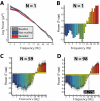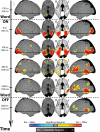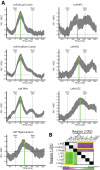Human intracranial high-frequency activity maps episodic memory formation in space and time
- PMID: 23827329
- PMCID: PMC4289670
- DOI: 10.1016/j.neuroimage.2013.06.067
Human intracranial high-frequency activity maps episodic memory formation in space and time
Abstract
Noninvasive neuroimaging studies have revealed a network of brain regions that activate during human memory encoding; however, the relative timing of such activations remains unknown. Here we used intracranially recorded high-frequency activity (HFA) to first identify regions that activate during successful encoding. Then, we leveraged the high-temporal precision of HFA to investigate the timing of such activations. We found that memory encoding invokes two spatiotemporally distinct activations: early increases in HFA that involve the ventral visual pathway as well as the medial temporal lobe and late increases in HFA that involve the left inferior frontal gyrus, left posterior parietal cortex, and left ventrolateral temporal cortex. We speculate that these activations reflect higher-order visual processing and top-down modulation of attention/semantic information, respectively.
Keywords: Electrocorticography; Functional mapping; Gamma; HFA; High-frequency activity; IFG; Inferior frontal gyrus; LFA; Low-frequency activity; Memory; PPC; Posterior parietal cortex; SM; Subsequent memory; VLTC; Ventrolateral temporal cortex.
© 2013 Elsevier Inc. All rights reserved.
Figures





References
-
- Adcock R, Thangavel A, Whitfield-Gabrieli S, Knutson B, Gabrieli JDE. Reward-motivated learning: Mesolimbic activation precedes memory formation. Neuron. 2006;50(3):507–517. - PubMed
-
- Addison PS. The illustrated wavelet transform handbook: Introductory theory and applications in science, engineering, medicine and finance. Institute of Physics Publishing; Bristol: 2002.
-
- Badre D, Wagner A. Left ventrolateral prefrontal cortex and the cognitive control of memory. Neuropsychologia. 2007;45(13):2883–2901. - PubMed
Publication types
MeSH terms
Grants and funding
LinkOut - more resources
Full Text Sources
Other Literature Sources

